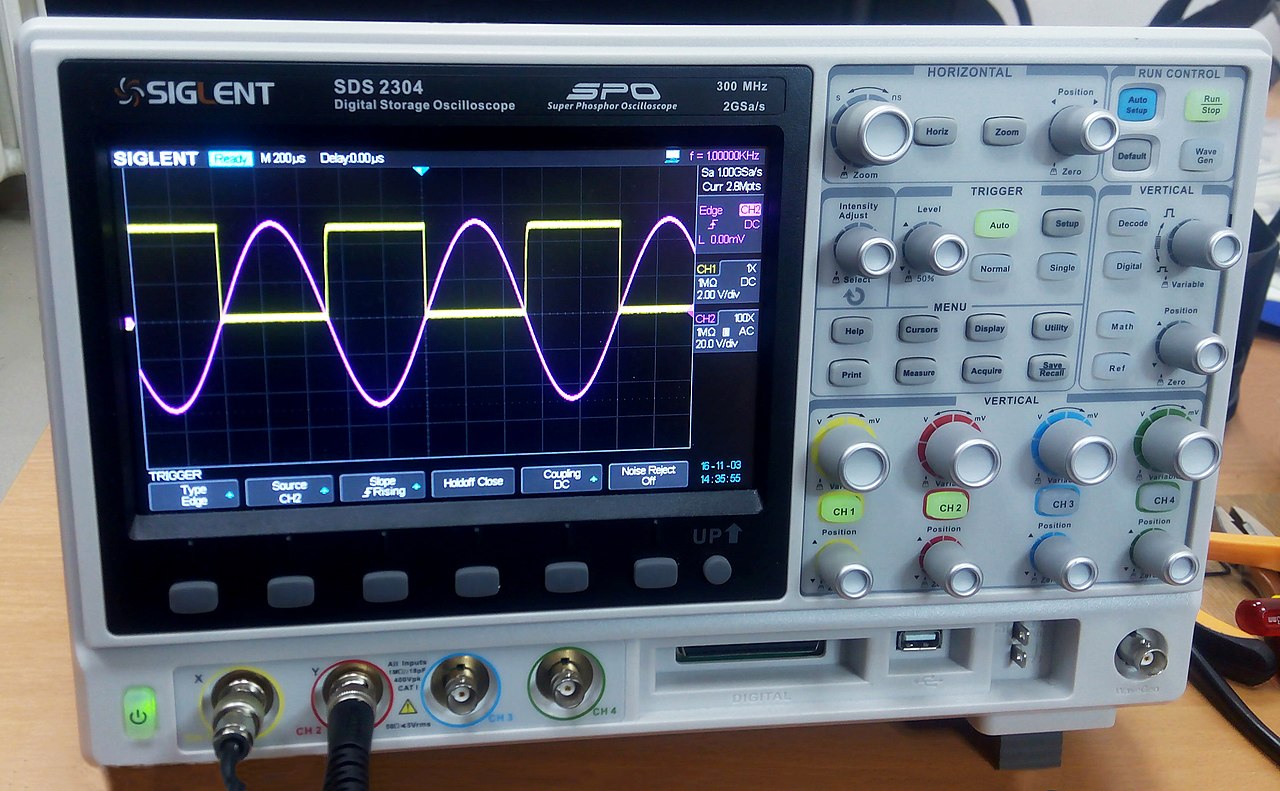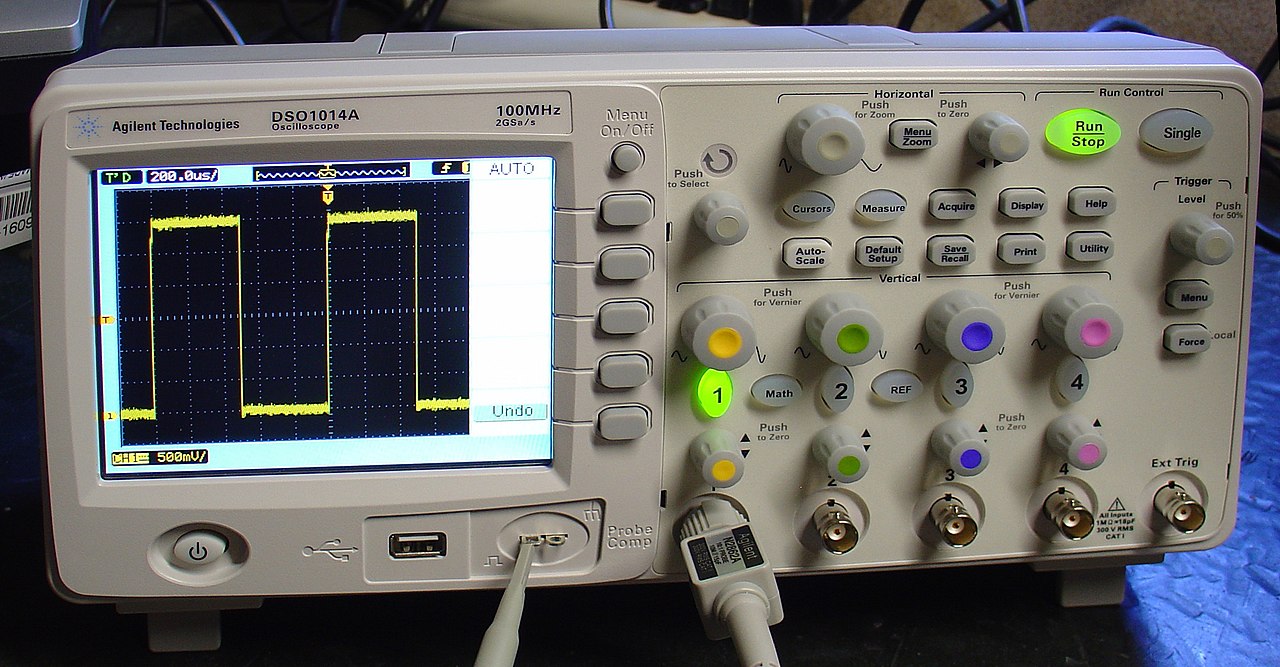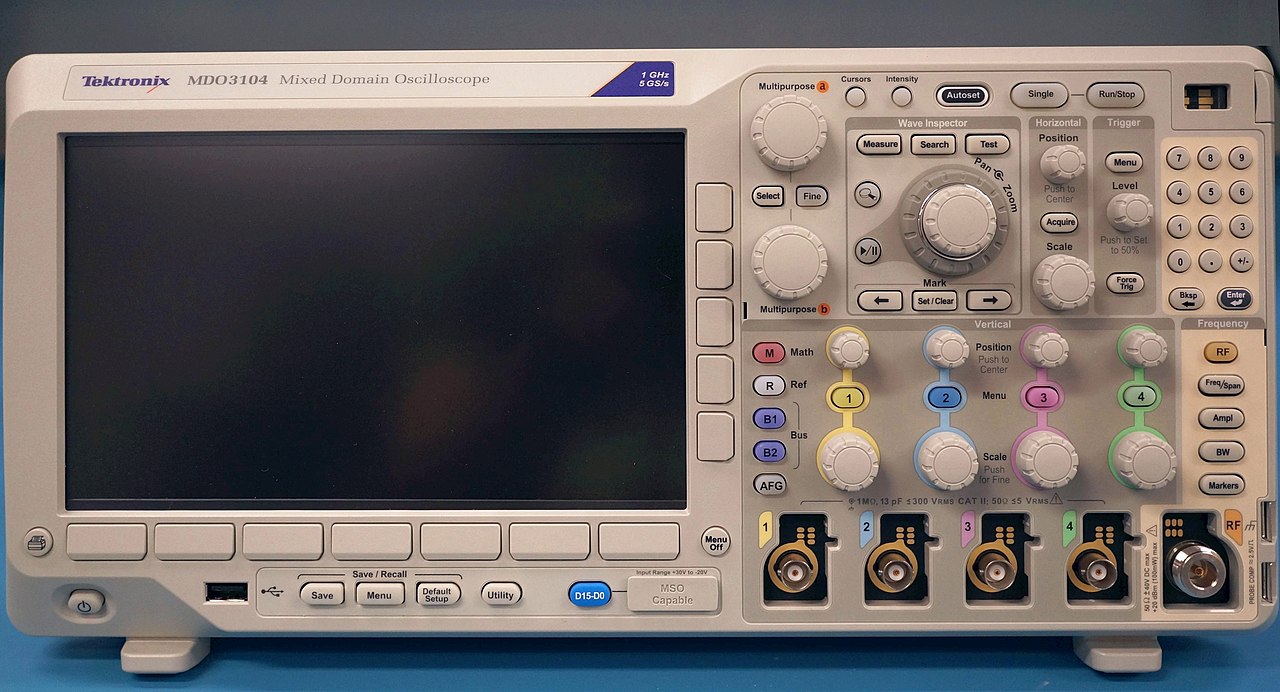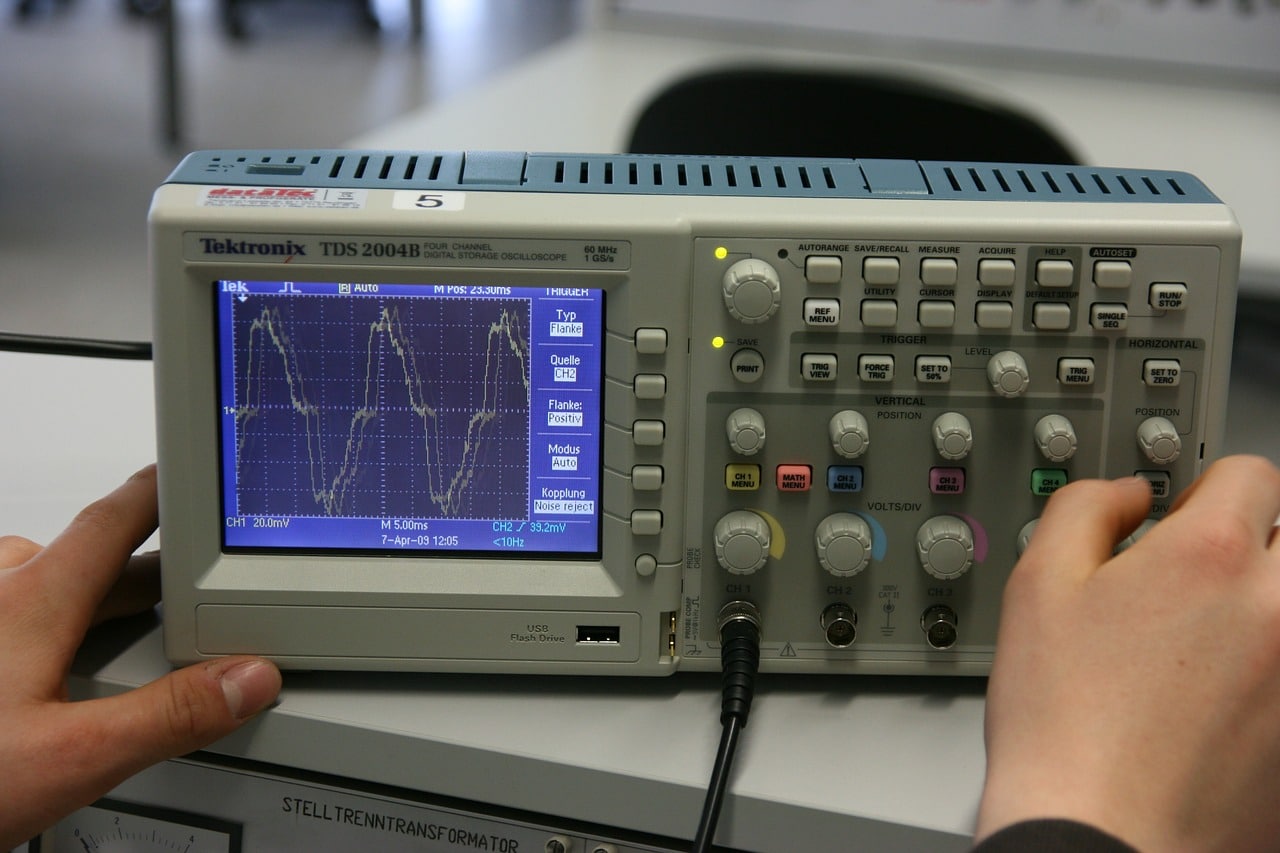
If you want to set up an electronics laboratory, one of the essential tools that should not be missing are oscilloscopes. With them you can not only take some measurements as with the polymers, but you will also see very graphic results on analog and digital signals. Undoubtedly one of the most professional and used tools in electronic laboratories, and here we will show you what exactly it is, how to choose the most suitable one for you, and we recommend some brands and models with the best value for money.
best oscilloscopes
If you don't know what device to buy, here you go a selection with the best oscilloscopes what can you buy. And there are for beginners, makers and professionals, with very varied price ranges. For this selection, I have selected the 3 best brands, and from each of them 3 different models are offered: a cheaper and more economical option for beginners and amateurs, an intermediate range, and a more expensive option for professionals.
Brand Rigol
Rigol DS1102Z-E (best price)
Rigol has some of the best digital oscilloscopes you can find, like this digital type model, with 2 channels, 100 Mhz, 1 GSa/s, 24 Mpts and 8-bits. Allows zooming in on a selected part, ability to scroll, fantastic connectivity, waveform capture speed up to 30.000 wfms/s, ability to display and analyze up to 60.000 recorded waveforms. All visible on its large 7″ color screen with TFT panel and WVGA resolution (800×480 px), adjustable brightness, vertical scale range from 1mV/div to 10V/div, USB connection, 2 probes and cables included, etc. .
Rigol DS1054Z (intermediate range)
No products found.
This is another one of the best digital oscilloscopes. Rigol has created a fantastic device with 4 channels instead of two like the previous one. With really interesting features, such as its 150 Mhz, 24Mpts, 1Gsa/s, 30000 wfms/s, as well as having triggers, decoding, support for different triggers, USB connection, and sharing many other features with the previous one, such as its 7 inches and 800×480 px resolution, its scale range, etc. It will automatically measure up to 37 waveform parameters, with statistics on rise and fall time, wave amplitude, pulse width, duty cycle, etc.
Rigol MSO5204 (best for professional use)
Rigol MSO5204 is another of the most interesting professional oscilloscopes. This device comes with 4 channels, 200 Mhz, 8 GSa/s, 100 Mpts, and 500000 wfms/s. It includes a 9″ color touch screen (multi-touch), with a capacitive LCD panel, and fantastic powerful hardware. It will capture and represent even the smallest detail. This screen has a magnificent resolution, with color stability, and up to 256 levels to adjust. You can automatically measure up to 41 different waveform parameters in memory. In this case, you will be able to use different interfaces, such as LAN, USB, HDMI, etc.
Brand Hantek
Hantek 6022BE (cheap digital)
This Hantek is very cheap, digital, and connects via USB to the PC. It does not include a screen, but it does include software (included on a CD) to install in Windows and be able to make visualizations through the screen of your computer with this software. It is designed in high quality anodized aluminum. It has 48 MSa/s, 20 Mhz bandwidth, and 2 channels (16 logical).
Hantek DSO5102P (intermediate range)
This other Hantek brand oscilloscope does have a color screen, with a size of 17,78 cm diagonal and WVGA resolution of 800 × 480 px. It has USB connector, 2 channels, 1GSa/s for real-time sampling, 100Mhz bandwidth, length up to 40K, four math functions to choose from, selectable edge/pulse width/line/slop/overtime trigger modes , etc. Real-time analysis PC software is included.
Hantek 6254BD (best digital for professional use)
Hantek also has this other model, one of the best oscilloscopes for professional use. A digital option, with USB connection, 250 Mhz, 1 GSa/s, 4 channels, arbitrary waveform, input sensitivity up to 2 mV-10V/div, easy to carry, easy to install (Plug & Play), very complete and with advanced functions, created with anodized aluminum for the casing, and with the possibility of viewing, storing, and performing all kinds of operations on the PC screen thanks to its software.
Siglent Brand
Siglent SDS 1102CML (more affordable option)
This other one is one of the most affordable that you can get under the Siglent brand. These oscilloscope models have a 7″ color TFT LCD screen, with a resolution of 480×234 px, USB interface, with PC software to remotely view and analyze everything through the screen, 150 Mhz wide of band, 1 GSa/s, 2 Mpts, and with double channel.
Siglent SDS1000X-U Series (intermediate range)
It is the intermediate Siglent model, with 4 channels, digital type, 100 Mhz bandwidth, 14 Mpts, 1 GSa/s, a 7-inch TFT LCD screen with a resolution of 800×480 px, super phosphor, with decoders for several interfaces, very easy to use thanks to its front panel, new system with SPO technology to improve fidelity and performance, high sensitivity, low jitter, captures up to 400000 wfmps, intensity adjustable in 256 levels, display mode of the color temperature etc
Siglent SDS2000X Plus Series (best for professional use)
If you want a Siglent for professional use, this other model is what you are looking for. A device with a huge 10.1″ multi-touch screen to monitor signals and data. With smart trigger (edge, slope, pulse, window, runt, interval, dropout, pattern and video). It has 4 channels and 16 digital bits, 350 Mhz bandwidth, 200 Mpts memory depth, voltage accuracy from 0.5 mV/div to 10V/div, various modes, 2 GSa/s, and capacity for 500.000 wfm/ s, 256 adjustable intensity levels, color temperature display, SPO technology to improve reliability, and packed with advanced features.
portable oscilloscopes
siglent SHS800 series (professional handheld oscilloscope)
A Professional Handheld Oscilloscope with 2 Channels, 200Mhz Bandwidth, 32Kpts Memory Depth, 6000 Count Display for Accurate Measurement, Trend Graphs of up to 32 Measurements, 800K Point Range, 24 Hour Recording Time , and great autonomy. Also, it has a recording time of 0.05 Sa/s.
HanMatek H052 (best value for money)
A mini size oscilloscope with 3.5″ TFT screen, with multimeter function (2 in 1). The screen is backlit, it has a self-calibration function, with up to 7 automatic averages, up to 10000 wfms/s, 50 Mhz, 250 MSa/s, 8K recording points, effective values in real time, independent multimeter and oscilloscope inputs, USB interface -C for power and charging, etc.
What is an oscilloscope?
oscilloscopes They are electronic instruments that are used to represent the different electrical variables on their LCD screen. of a circuit, generally signals that vary with time represented on a coordinate axis (X for the time axis to see the evolution of the signal and on the Y axis the amplitude of the signal is represented in volts, for example). They are essential in the field of electronics to analyze circuits and check signal values (analog or digital), as well as their behavior.
Oscilloscopes have probes or tips with which to obtain the signals of the circuit being studied. The oscilloscope electronics will take care of represent them visually on the screen, checking from time to time the changes (sampling), and through the trigger controls it will be possible to stabilize and display repetitive waveforms.
- Sampling: is the process to convert a part of an incoming signal into a number of discrete electrical values in order to store it in a memory, process it and display it by representing it on the screen. The magnitude of each sample point will be equal to the amplitude of the input signal at the time the signal is sampled. These plotted points on the screen can be interpreted as waveforms through a process known as interpolation, connecting the points to form lines or vectors.
- Shots: Used to stabilize and display a repetitive waveform. There are several types such as edge triggering, determining if the edge is rising or falling in a signal, ideal for square or digital signals. Pulse width triggering can also be used to analyze more complex signals. There are also other modes, such as single trigger, where the oscilloscope will only display a trace when the input signal meets the trigger conditions, updating the display and freezing it to maintain the trace.
Signal parameters
Oscilloscopes can measure a series of signal parameters you should know:
- Effective value
- Maximum event value
- Minimum event value
- Peak to peak value
- Signal frequency (both low and high)
- signal period
- sum of signals
- Signal rise and fall times
- Separate the signal from the noise that may be coupled
- Calculate propagation times in microelectronic circuits
- Calculate the FFT of a signal
- See impedance changes
Oscilloscope Parts
As for the fundamental parts of an oscilloscope that you must know to be able to handle it, they are:
- Screen: is the representation system of signals and values. This display used to be a CRT on older oscilloscopes, but on modern oscilloscopes it is now a digital TFT LCD display. These screens can be of different sizes, and with different resolutions, such as VGA, WXGA, etc.
- upright system: is responsible for providing the representation system with the signal information for the Y axis or vertical axis. It is usually represented on the front of the oscilloscope and has its own zone of controls labeled VERTICAL. For example:
- Scale or vertical gain: Adjusts the vertical or constant sensitivity in volts/division. There will be a control for each of the channels that the oscilloscope has. For example, if you choose 5V/div then each of the screen divisions will represent 5 volts. You must adjust it based on the signal voltage, so that it can be properly represented on the graph.
- Menu : allows you to choose between different configurations of the chosen channel, such as input impedance (1x, 10x,…), signal coupling (GND, DC, AC), gain, bandwidth limitations, channel inversion (inverts polarity), etc.
- Position: is the command used to move the trace of the signal vertically and place it where you want.
- FFT: Fast Fourier Transform, an option to use a mathematical function to perform a spectral analysis of the signal. So you can see the signal broken down into fundamental frequency and harmonics.
- Math: Digital oscilloscopes also often include this setting to choose various mathematical operations to apply to signals.
- horizontal system: is the data represented horizontally, with a sweep generator used to control the sweep speeds and that can be adjusted in time (ns, µyes, ms, seconds, etc.). All settings or controls for this X axis are grouped in an area labeled HORIZONTAL. For example, depending on the model you can find:
- Position: allows you to move the signals along the X axis to adjust them, for example, place a signal at the beginning of a cycle, etc.
- Scale: This is where the unit of time per screen division (s/div) can be set. For example, you can use one of 1 ms/div, which will make each division of the graph represent a time span of one millisecond. Nanoseconds, microseconds, milliseconds, seconds, etc. can be used, depending on the sensitivity and scale supported by the model. This control can also be understood as a kind of "zoom", to analyze more minute details of a signal in a smaller moment.
- Acquisition: The acquired data is converted to digital format, and this can be done in 3 possible ways and will affect the sampling, that is, the speed with which the data is acquired. The three modes are:
- Sampling: Samples the input signal at regular time intervals, but might miss some rapid variations in the signal.
- Average: This is a highly recommended mode for when a series of waveforms are acquired, taking an average of all of them and displaying the resulting signal on the screen.
- Peak detection: appropriate if you want to reduce the coupled noise that a signal can have. In this case, the oscilloscope will look for maximum and minimum values of an incoming signal, thus representing the signal in pulses. However, care must be taken, as in this mode the coupled noise may appear larger than it actually is.
- trigger: the trigger system indicates when we want the signal to start drawing on the screen. For example, imagine that you have used a base 1 time scale µs and the X-axis graph of time has 10 horizontal divisions, then the oscilloscope will plot 100.000 graphs per minute, and if each one starts at a different point it would be chaos. So that this does not happen, in this section you can act for it. Some controls are:
- Menu : selector for the different options or possible shooting modes (manual, automatic,...).
- Level or Level: this potentiometer allows adjusting the trigger level for a signal.
- force trigger: force the shot at the moment of pressing it.
- Probes: are the terminals or test points that will be in contact with the parts of the device or circuit to be analyzed. They must be adequate, otherwise the cable that connects the probe to the oscilloscope could act as an antenna and pick up parasitic signals from nearby telephones, electronic devices, radio, etc. Many probes come with a potentiometer to compensate for these issues and need calibration to display correct values on the display, consistent with the chosen scales on the display axes.
Oscilloscope Safety
Another important aspect when using an oscilloscope in a laboratory is to keep in mind security measures so as not to end up damaging the device or with accidents that may affect you. It is always essential to read the manufacturer's manual to respect the recommendations for safety and use. Some generic rules common to all models are:
- Avoid working in environments with flammable or explosive products.
- Wear protective gear to avoid burns or electrocutions.
- Ground all grounds, both the oscilloscope probe and the circuit under test.
- Do not touch circuit components or bare probe tips that are live.
- Always connect the equipment to a safe and grounded power supply network.
Applications
If you still can't find him an app To this device, you should know everything that allows you to perform oscilloscopes in your electronics laboratory:
- Measure signal amplitude
- measure frequencies
- measure impulses
- measure cycles
- Average of the phase shift of two signals
- XY measurements using Lissajous figures
Well, and this expressed in a more practical way, can be used for:
- Check electronic components, cables or buses
- Diagnose problems in a circuit
- Check analog or digital signals in a circuit
- Determine the quality of electronic signals in critical systems
- Reverse engineering of electronic devices
- And even oscilloscopes can go beyond electronics and use their properties of measuring certain electrical signals to modify them and monitor biomedical parameters of patients in a hospital, such as their blood pressure, respiratory rate, electrical nerve activity, etc. Can also be used to measure sound power, vibrations and more
Types of oscilloscopes
There are different types of oscilloscopes. For example, depending on how the signal measurements are taken, we have:
- Analog: the voltage measured by the probes will be displayed on the CRT screen, without transformations from analog to digital. In these, periodic signals are captured, while transient phenomena are not usually reflected on the screen, unless they are repeated periodically. In addition, this type of oscilloscope has limitations, such as that it does not capture signals that are not periodic, when capturing very fast signals they reduce the brightness of the screen due to the decrease in the refresh rate, and signals that are too slow will not form traces (only can in high persistence tubes).
- digital: similar to the previous ones, but they acquire the analog signal by the probe and convert it into digital by means of an ADC (A/D Converter), which will be processed digitally and displayed on the screen. They are currently the most widespread given their advantages, such as being able to connect to the PC to analyze the results using software, store them, etc. On the other hand, thanks to their circuitry they can add functions that the analog ones lack, such as the automatic measurement of peak values, edges or intervals, transient capture, and advanced calculations such as FFT, etc.
They can also be cataloged according to its portability or use:
- portable oscilloscope: they are compact and light instruments, to facilitate taking them from one place to another to carry out the measurements. They can be interesting for technicians.
- Laboratory or industrial oscilloscope: they are larger, benchtop devices, much more powerful and designed to be left in a fixed place.
On the other hand, according to technology used, one could also distinguish between:
- DSO (Digital Storage Oscilloscope): This digital storage oscilloscope uses a serial processing system. It is the most common type within digital oscilloscopes. They can capture transient events, store them in files, analyze them, etc.
- DPO (Digital Phosphor Oscilloscope): These cannot show the level of intensity of a signal in real time as it happens in analog, but DSO cannot. That is why the DPO was created, which was still digital but solved that problem. These allow faster signal capture and analysis.
- Of sampling: trade higher bandwidth for lower dynamic range. The input is not attenuated or amplified, being able to handle a full range of signal. This type of digital oscilloscope only works with repetitive signals, and cannot capture transients beyond the normal sample rate.
- MSO (Mixed Signal Oscilloscope): they are a hybridization between the DPOs and a 16-channel logic analyzer, including decoding and activation of the parallel-serial bus protocol. They are best for checking and debugging digital circuits.
- PC based: Also known as a USB oscilloscope as they do not have a display, but rely on software to display results from a connected PC.
Although there may be other types, these are the most popular, and the ones you will usually find.
How to choose the best oscilloscope
When choose a good oscilloscope, you should take into account some of the following characteristics. In this way, you will be able to choose the best and most suitable for your use:
- What do you want the oscilloscope for? It is important to determine what you are going to use it for, since an oscilloscope to analyze digital circuits at a logic level is not the same as one for RF, or that you have to transport from one place to another, etc. In addition, it is also important to determine if you want it for professional use or for hobby use. In the first case, it is worth investing a little more to obtain a more professional and precise equipment. In the second case, it is better to opt for something with a medium-low price.
- Budget: knowing how much you have available to invest in your equipment will help you rule out many models that are out of budget and will reduce the range of possibilities.
- Bandwidth (Hz): Determines the range of signals you can measure. You should choose an oscilloscope that has enough bandwidth to accurately capture the highest frequencies of the signals you'll be working with. Remember the rule of 5, which is to choose an oscilloscope that, together with the probe, offers at least 5 times the maximum bandwidth of the signal you usually measure for best results.
- Rise time (= 0.35/Bandwidth): It is essential to analyze pulses or square waves, that is, digital signals. The faster it is, the more accurate the time measurements. You should choose scopes with rise times less than 1/5 times the fastest rise time of the signal you are going to use.
- Probes: There are some oscilloscopes that have several special probes for different requirements. Many of today's oscilloscopes typically come with high impedance passive probes and active probes for higher frequency measurements. For the medium range it is better to choose probes with capacitive loads of < 10 pF.
- Sampling rate or frequency (Sa/so Samples per Second): will determine how many times details or values of the wave to be measured are captured per unit of time. The higher it is, the better the resolution and the faster it will use memory. You should choose an oscilloscope that has at least 5x times the highest frequency of the circuit you are going to analyze.
- Activation or triggering: Best if it offers more advanced triggers for complex waveforms. The better it is, the better you will be able to detect possible anomalies that are difficult to locate.
- Memory depth or record length (pts): The more, the better resolution for complex signals. Indicates the number of points that can be stored in memory, that is, the capacity to store previous results while performing an experiment. The number of readings can be recorded and all the values can be seen to draw more precise conclusions or follow up.
- Number of Channels: Choose the oscilloscope with the proper number of channels, the more channels, the more details can be acquired. The analog ones used to be only 2 channels, while the digital ones can go from 2 and up.
- Interface: It should be as intuitive and simple as possible, especially if you are a beginner. Some advanced oscilloscopes are only suitable for professionals, since a less experienced user would need to constantly read the manual.
- Analog vs digital: the digital ones are the current dominant ones in the market due to their advantages, such as allowing greater ease, and without limitations in the length of the record. Therefore, the preferred option should definitely be a digital oscilloscope for almost all cases.
- Brands: the best oscilloscope brands are Siglent, Hantek, Rigol, Owon, Yeapook, etc. Therefore, buying one of their models will be a guarantee of good performance and quality.













